| Relevant paintings: 
"Garden with flowers," Vincent van Gogh
[Enlarge]

"Garden with sunflowers," Vincent van Gogh
[Enlarge]
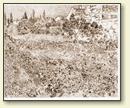
"Garden with flowers," Vincent van Gogh
[Enlarge]
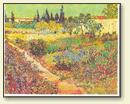
"Flowering Garden with Path," Vincent van Gogh
[Enlarge]
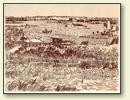
"Harvest landscape," Vincent van Gogh
[Enlarge]
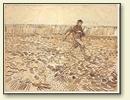
"Sower," Vincent van Gogh
[Enlarge]

"Fishing boats at sea," Vincent van Gogh
[Enlarge]
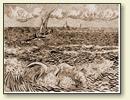
"Fishing boats at sea," Vincent van Gogh
[Enlarge]

"Flowering Garden," Vincent van Gogh
[Enlarge]

"Seated Zouave," Vincent van Gogh
[Enlarge]
|
My dear Theo,
I have just sent off three big drawings, as well as some
other ones, and the two lithographs by de Lemud.
The little cottage garden done vertically is, I think, the
best of the three big ones. The one with the sunflowers is a
little garden of a bathing establishment, the third garden,
horizontal, is the one from which I made some painted studies
as well.
Under the blue sky the orange, yellow, red splashes of the
flowers take on an amazing brilliance, and in the limpid air
there is a something or other happier, more lovely than in the
North. It vibrates like the bouquet by Monticelli which you
have. I reproach myself for not painting flowers here. And
although I've knocked off some fifty drawings and painted
studies here, I seem to have done absolutely nothing. I'd
gladly content myself with being a pioneer for the other
painters of the future who come to work in the South.
Now the Harvest, the Garden, the Sower, and
the two marines
are sketches after painted studies. I think that all these
ideas are good, but the painted studies lack clearness of
touch. That is another reason why I felt it necessary to draw
them.
I wanted to paint a poor old peasant, whose features bear a
very strong resemblance to Father, only he is coarser,
bordering on a caricature.
Nevertheless, I should have been very keen to do him exactly
like the poor peasant that he is.
He promised to come, and then he said that he wanted to have
the picture for himself, so that I should have had to do two
the same, one for him and one for myself. I said No. Perhaps he
will come back someday.
I am curious to hear if you knew the de Lemuds.
At the moment there are still many fine lithographs to be
had, Daumiers, reproductions after Delacroix, Décamps,
Diaz, Rousseau, Dupré, etc. But soon these will be
exhausted, and what a great pity it is that this art tends to
disappear.
Why doesn't one hold what one has, like the doctors and the
engineers; once a thing is discovered and invented, they retain
the knowledge; in these wretched Fine Arts everything is
forgotten, nothing is kept.
Millet gave the synthesis of the peasant, and now, yes,
there is Lhermitte, certainly there are a few others,
Meunier…Then have we in general learned to see
the peasant now? No, hardly anyone knows how to pull one
off.
Doesn't the fault really lie a little with Paris and the
Parisians, changeable and faithless as the sea?
Well, you have damn good reason to say: Let's go quietly on
our way, working for ourselves. You know, whatever this
sacrosanct impressionism may be, all the same I wish I could
paint things that the generation before Delacroix,
Millet, Rousseau, Diaz, Monticelli, Isabey, Décamps,
Dupré, Jongkind, Ziem, Israëls, Meunier, a lot of
others, Corot, Jacque, etc., could understand.
Ah, Manet has come very near, very near to it, and Courbet,
the wedding of form to colour. I would very much like to keep
silent for ten years, doing nothing but studies, and then do
one or two pictures of figures. The old plan, so often
recommended, is so seldom put into practice.
If the drawings I send you are too hard, it is because I
have done them in such a way as to be able later on, if they're
still around, to use them as guides for painting.
The little cottage garden done vertically has in itself
amazing colours: the dahlias are a rich and sombre purple; the
double row of flowers is pink and green on one side, and orange
with hardly any leaves on the other. In the midst a white dwarf
dahlia, and a little pomegranate with flowers of the most vivid
reddish-orange, with yellowish-green fruits. The ground gray,
the tall reeds, “canes,” blue-green, the fig trees
emerald, the sky blue, the houses white with green windows and
red roofs, in the morning full in the sunshine, in the evening
drowned in the shadows thrown by the fig trees and the
reeds.
If only Quost were here, or Jeannin! What's to be done? To
include it all requires a whole school of men working together
in the same country, complementing one another like the old
Dutchmen, portrait painters, “genre” painters,
landscape, animal, still-life painters.
Moreover I must tell you that I made a very interesting
round of the farms with someone who knows the country. But you
know in the real Provence there is more poor peasantry à
la Millet than anything else.
McKnight and Bock see nothing but the heat, or rather
nothing at all. Now even if I begin to see things a little more
clearly, it will take a very long stay to do them.
At times, however, it seems likely that it is I who shall
have to make the journey if Gauguin does not succeed in getting
out of the mess and we want to carry out our plan. Well then,
so be it, I shall be among peasants just the same, it's all
one. I should even advise our trying to hold ourselves in
readiness to go to him, for I think that soon he may find
himself in terrible trouble again, for instance if his landlord
is not willing to give him any more credit. That is so likely
to happen, and his difficulties might be so great that starting
the combination might become urgent. For me there is only the
cost of the one-way trip, and the prices there which he has
quoted are in every instance considerably lower than what we
are bound to spend here.
I count on having your letter on Saturday morning; so that already, on Wednesday
evening, I have exactly 5 francs left.
Only here there is still one advantage over the North during
days of penury, that is the fine weather (for even the mistral
is fine weather to look at). Perfectly glorious sunshine
in which Voltaire let himself dry as he drank his coffee. You
can't help feeling Zola and Voltaire everywhere. It is so
alive! Like Jan Steen, like Ostade.
Certainly there would be a chance for a school of painting
here, but you will tell me that nature is beautiful everywhere
if you go into it deeply enough.
Have you read Madame Chrysanthème yet, have you
already made the acquaintance of that so amazingly obliging
ruffian M. Kangarou? And of the sugared peppers, and the fried
ices, and the salted sweets?
In a cottage garden I saw a figurehead of a woman carved in
wood, from the bow of a Spanish ship. It was in a little grove
of cypresses, and absolutely Monticelli.
Oh, these farm gardens, with their lovely big red
Provençal roses, and the vines and the fig trees! It is
all a poem, and the eternal bright sunshine too, in spite of
which the foliage remains very green.
There is a cistern running clear water which irrigates the
farm along trenches in a complete little system of canals. A
horse, an old white animal from the Camargue, sets the
machinery in motion.
No cows on these little farms.
My neighbor and his wife (grocers) are amazingly like the
Buteaux.
But here farms and low pubs are less dreary and less
dramatic than in the North, since the warmth, etc., makes
poverty less harsh and melancholy.
I do wish you had seen this country. Well, first we must see
how the Gauguin business will turn out.
I haven't yet told you that I had a letter from Koning. I
wrote him a week ago. I can easily see him coming back. Is
Mourier still there?
I'd be astonished if that book of Cassagne's were out of
print. They ought to know it, or know where it could be got, at
Lalouche's or at the colour shop in the Chaussée
d'Antin. If I ever come to give lessons in drawing, or to have
to speak to painters on the principles of technique, I must
have it at hand. It is the only really practical book I
know, and I know pretty well from experience how useful it is.
Mourier, McKnight, even Bock, all need it, and how many others
too. McKnight is always dropping in.
I have again been working on a portrait of a Zouave sitting
on a bench against a white wall, which makes a fifth figure.
This morning I was at a washing place with figures of women,
as big as Gauguin's Negresses, one especially in white, black,
red, and another one all in yellow; there were at least thirty
of them, old and young.
I am hoping to send you some more sketches after the painted
studies.
I hope to hear from you soon, with a handshake.
Ever yours, Vincent
At this time, Vincent was 35 year oldSource:
Vincent van Gogh. Letter to Theo van Gogh. Written 8 August 1888 in Arles. Translated by Robert Harrison, edited by Robert Harrison, number 519.
URL: https://www.webexhibits.org/vangogh/letter/18/519.htm.
This letter may be freely used, in accordance with the terms of this site.
|